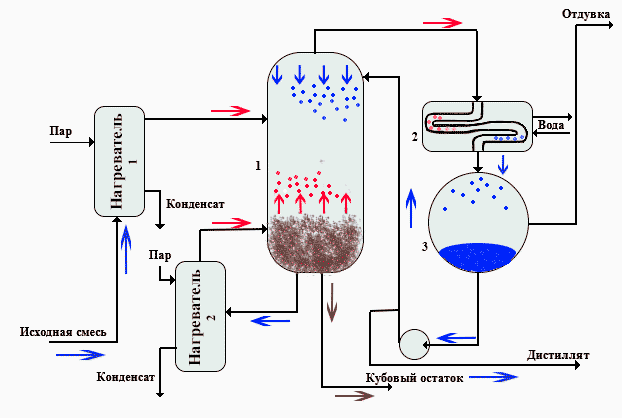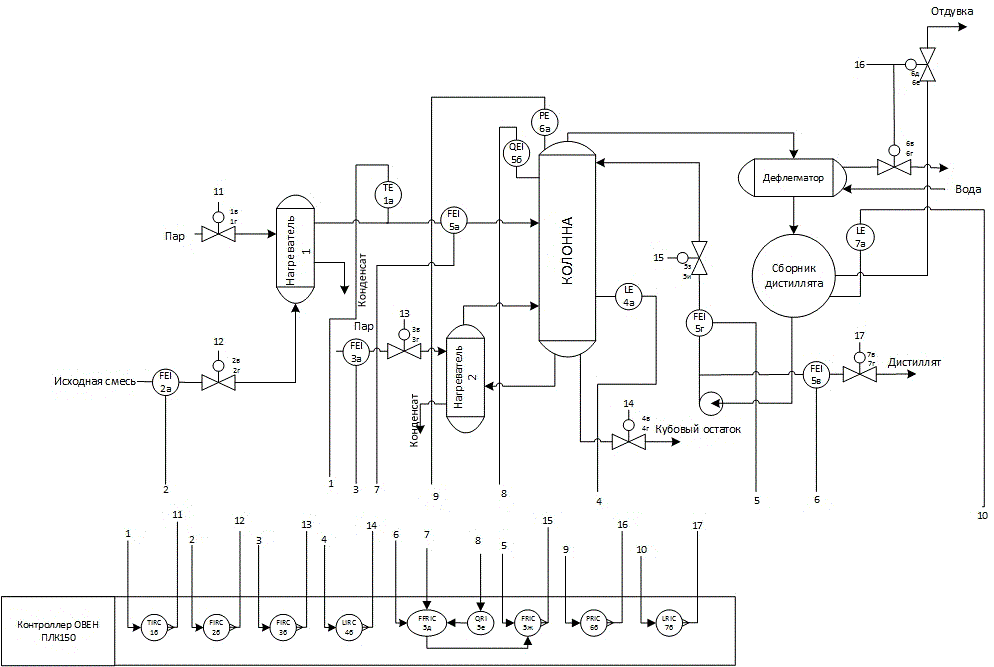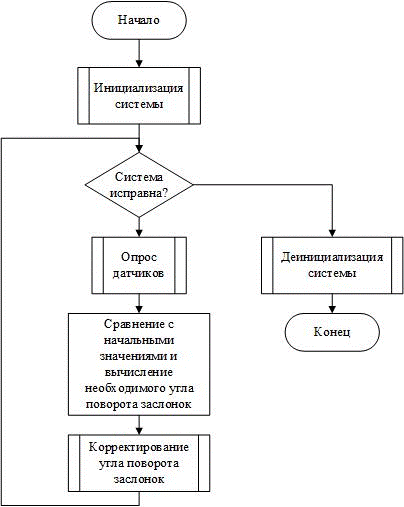Savchuk Maksim
Faculty of computer information technologies and automation (CITA)
|
Abstract
Introduction- Relevance of the topic
- The purpose and objectives of the study, expected results
- Review of research and development
- Development of functional circuits and algorithms
Sources
Introduction
To date, automation has reached significant heights. With the advent of the PLC, we were able to automate virtually any technological process, for which previously required the participation of dozens of employees. In most cases, various objects modeling, neglecting their minor perturbations and controlled quantities. This greatly simplifies the model, but in some cases it is necessary to take into account a greater number of perturbation and control parameters. The complexity of such objects is that changing the parameters at one input can entail changing several outputs, with different coefficients. To describe such objects it is necessary to use different approaches, such as the method of decomposition and decentralization, vector functions, and so on.
1. Relevance of the topic
There is a large number of objects with several control actions that it is highly undesirable to neglect. Similarly, all real objects have some kind of delay, which is often neglected. In some systems, where the duration of such a delay can reach several minutes, or ten minutes, such neglect is also unacceptable. Thus, it can be concluded that it is necessary to create a management system for such an object, taking into account all previously omitted indicators.
In the framework of this work, as a multidimensional object, we attach ourselves to the process of distilation of alcohol, which under real conditions has about 8 possible control actions and create a control system for such an object.
2. The purpose and objectives of the study, expected results
When analyzing the object and existing solutions for its automation, it was decided to partially simplify it, in the form of limiting the number of control actions and considering the rest in the form of disturbances. Thus, the purpose of the work can be formulated as follows: improving the quality of separation of the mixture in ACS by introducing corrective circuits for the rate of phlegm, the initial mixture, the distillate and the concentration of the LBC.
To achieve the goal you need to solve the following tasks:
- Analyze the technological scheme of the distillation process.
- Develop a functional diagram and perform a selection of hardware for the implementation of the ACS.
- Perform synthesis of ACS.
- Check the performance of the automatic control system by mathematical modeling.
3. Review of research and development
At the moment, there are many businesses that are engaged in alcohol distillation, but all of these are commercial structures, which is why all of the information associated closed to outsiders. This greatly complicates the search for information on this topic. However, there are a lot of sites, forums and articles devoted to distilation at home, which allows us to use some of this data in this work.
3.1 Overview of international sources
There are many sources on the subject of multidimensional objects with delays in foreign space, but not all of them are publicly available.
- Title: Topics in Time Delay Systems: Analysis, Algorithms and Control. Lecture Notes in Control and Information Sciences (Том 388)
- Authors: Jean Jacques Loiseau, Wim Michiels, Silviu–Iulian Niculescu, Rifat Sipahi
- Publisher: Springer, 2009
- ISBN: 3642028977, 9783642028977
- Pages: 418
One of the books about various types of control of objects with delay, which is in closed access.[1]
Publication: L. Fridman, P. Acosta – Steady Modes in the Multidimensional Relay Control Systems with Time Delay // Functional differential equations, Vol 7, No 3–4 (2000) ISSN: 0793–1786. Article devoted to the study of stable regimes when working with a multidimensional object with delay.[2]
3.2 Overview of national sources
On the Russian-language space there are also articles on the subject of multidimensional objects. But because of the huge amount of amateur articles on the subject of rectification, it is difficult to find scientific publications with useful information.
Publications: Федосов Б. Т. – Многомерные объекты. Описание, анализ и управление, Уравнения состояния динамических объектов с запаздыванием. Two articles on the subtleties of designing multidimensional objects and objects with delay.[3][4]
Publication: О. Ю. Камкин, О. А. Ремизова, В. В. Сыроквашин, А. Л. Фокин – Робастная стабилизация многомерного линейного объекта с запаздываниями по управлениям. Article about robust stabilization of objects.[5]
3.3 Overview of local sources
Within the framework of the Donetsk National Technical University (DonNTU), one work was found with a similar theme and several works related to this topic.
Work of Master DonNTU Pavlenko A. – Исследование динамики многомерной системы автоматического регулирования сушильным агрегатом [6]. As part of this work, the drying unit is considered as a multidimensional object and analyzes the technical process in general.
Work of Master of DonNTU Maslennikova S. – Исследование и разработка САУ температуры трубчатой печи типа ПТБ –10Э в условиях Лисичанского НПЗ [7]. In work as a multidimensional object a tubular furnace is represented.
Work of the Master of DonNTU Isaev P. – Оптимизация режимов работы ректификационного оборудования. [8] In this study, we carried out the analysis of methods of optimization of operating modes of the rectification equipment.
4. Development of functional circuits and algorithms
4.1 Designing of automatic control system
To perform the tasks it is supposed to obtain information about the parameters characterizing and influencing the operation modes of the object.
-
Для того чтобы обеспечить эффективное управление объектом необходимо:
- – Measure the flow rate of the initial mixture, the boiling feed mixture, reflux, distillate, steam in the remote reboiler
- – Measure the temperature of the feed mixture
- – Measure the level of bottom residue in the bottom of the column, reflux in the reflux tank
- – Measure the pressure at the top of the column
- – Measure the concentration НКК
- – Manage the supply of steam to the heat exchanger and boilerManage the feed of the feed mixture
- – Manage the flow of reflux
- – Manage Reflux Cooling
- – Manage the level of reflux and bottoms
- –
Based on the requirements, there is a need to connect a plurality of sensors: flow sensors, a temperature sensor, level sensors, a pressure sensor, a vapor concentration sensor.
Thus, to perform the tasks set, it is advisable to use an industrial controller to manage the system.
Based on the given requirements, we construct the general functional diagram of Fig. 4.1
Figure 4.1 – General Functional Scheme of the Rectification Column
In Fig. 2.1, the РЗ is an adjustable damper, the ЭП is an electric drive, the ДР is a flow sensor, the ДТ is a temperature sensor, the ДК is a concentration sensor, the ДУ is a level sensor, the ДД is a pressure sensor, and the ПК is a personal computer.

Figure 4.2 – Principle of operation of the distillation column (animation: 6 frames, 10 repetition cycles, 45 kilobytes)
Automatic devices and computer facilities that implement control functions must be selected taking into account the complexity of the object and its fire; and explosiveness, aggressiveness and toxicity of the environment, the kind of measured technological parameter, the range of signal transmission from sensors and actuators with control points, the required accuracy and speed, the permissible error of measuring systems, the location of the device, the requirements of the rules for the installation of electrical equipment. It should be borne in mind that preference should be given to the same type of centralized devices. This will greatly simplify the installation, and then the operation of the control system.[9]
4.2 Functional scheme development
Based on the selected elements, we construct a functional diagram of the rectification column control system in Fig. 4.2.

Figure 4.3 – functional diagram of the ACS rectification column
4.3 Development of software algorithms for ACS
The development of the control software for the distillation column is quite a difficult task, so we will limit ourselves to the general scheme of the system operation.
When starting the ACS, it is necessary to perform initial initialization: run the control program on the operator's PC, reset all program variables, check the operability of all system sensors, and the system as a whole. Communication of the computer with the PLC is provided by RS-485. With it, you can monitor and control the process. Next, the program is run on the computer and the required flow and temperature values are entered to start the system. The further work of the program is carried out cyclically. Interrogation of all sensors, processing of the received values from them, output of information to the monitor is carried out.
Next, the program will compare the data obtained from the sensors with predetermined values, which were introduced earlier, and if any parameter is outside the permissible range, the PLC takes control action for the corresponding actuator.
All of the above can be presented in the form of a block diagram:

Figure 4.4 – Block diagram of the algorithm of the program
Conclusions
-
In this project, the task of automating the regulation of the rectification process is solved. The main tasks of the project are determined, the solution of which will allow to develop an effective management system with energy-intensive management. According to the results of the work at the moment, the following main conclusions can be drawn:
- –As a control object, the technological process of rectification of alcohol is considered. Analyzing the TP of the distillation column as a control object, it was found that this object has a high delay. The methods of regulating a particular type of equipment are given.
- –The chosen direction of development is analyzed and justified. The requirements for the elements of the automatic control system have been set. A functional scheme has been developed and described.
- –The algorithm of the program for controlling the distillation process was implemented.
When writing this essay, the master's work is not yet complete. The final completion is May 2018.
Sources
- Topics in Time Delay Systems: Analysis, Algorithms and Control / J.J. Loiseau, R.W. Sipahi, W. Michiels, S. I. Niculescu. – India: Springer, 418 pp.
- Fridman L. Steady Modes in the Multidimensional Relay Control Systems with Time Delay / P. Acosta // Functional differential equations, Vol 7, No 3 – 4 (2000) – http://functionaldifferentialequations.com
- Федосов Б.Т. Многомерные объекты. Описание, анализ и управление. – http://model.exponenta.ru
- Федосов Б.Т. Уравнения состояния динамических объектов с запаздыванием. – http://model.exponenta.ru
- Робастная стабилизация многомерного линейного объекта с запаздываниями по управлениям / О.Ю. Камкин, О.А. Ремизова, В.В. Сыроквашин , А.Л. Фокин. – Известия высших учебных зеведений. Приборостроение. – 2013. – T. 56. – №10. – http://openbooks.ifmo.ru
- Павленко А.А. Исследование динамики многомерной системы автоматического регулирования сушильным агрегатом. – http://masters.donntu.ru
- Масленникова С.В. Исследование и разработка САУ температуры трубчатой печи типа ПТБ–10Э в условиях Лисичанского НПЗ. – http://masters.donntu.ru
- Исаев П.С. Оптимизация режимов работы ректификационного оборудования. – http://masters.donntu.ru
- Дытнерский Ю.И. Процессы и аппараты химической технологии. / Ю.И. Дытнерский. – М.: Химия, 1995г, 768 с.
- Лукас В.А. Теория автоматического управления: Учебник для вузов / В.А. Лукас – 2–е издание. – М: Недра, 1990. – 416 с.
